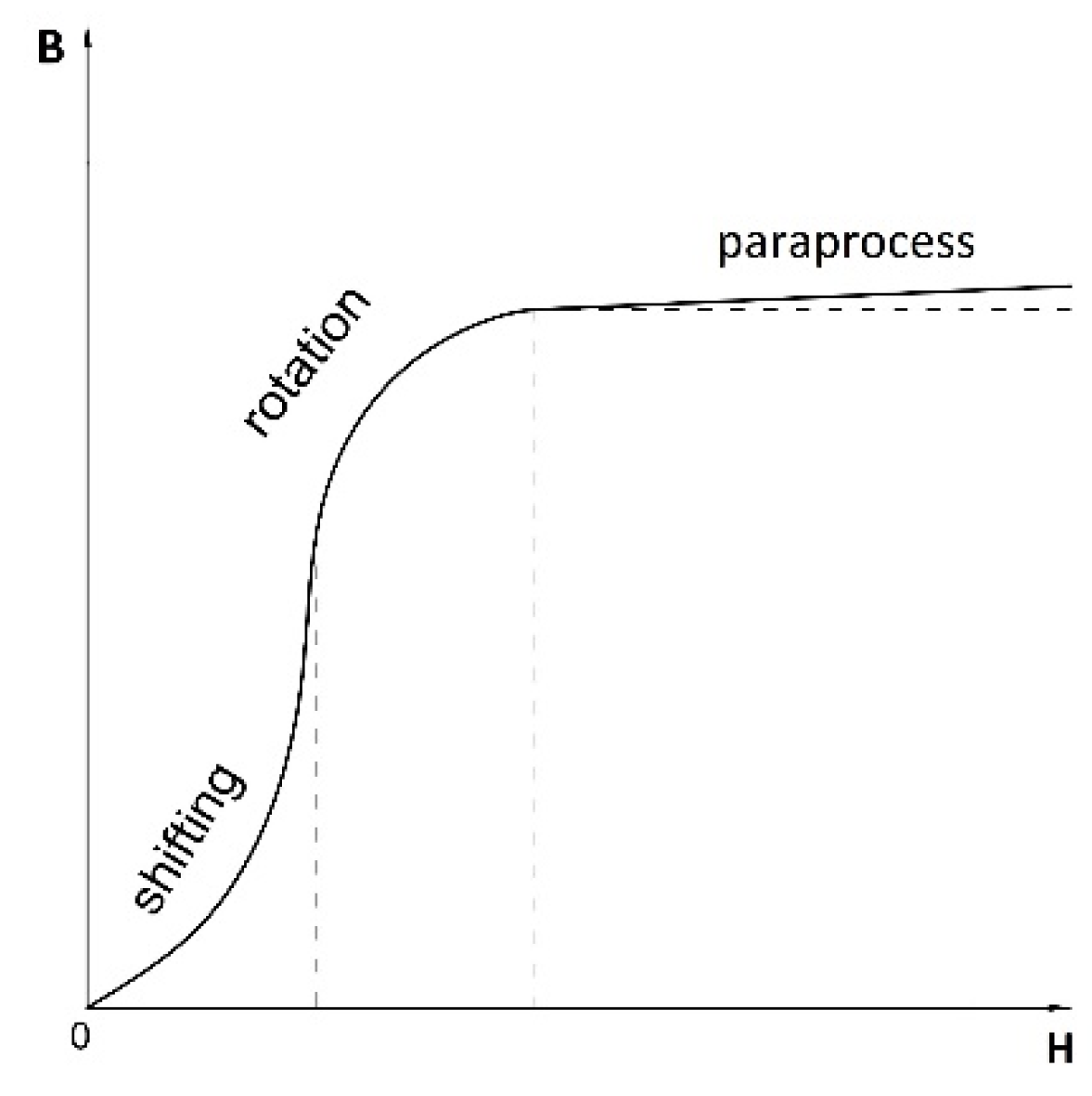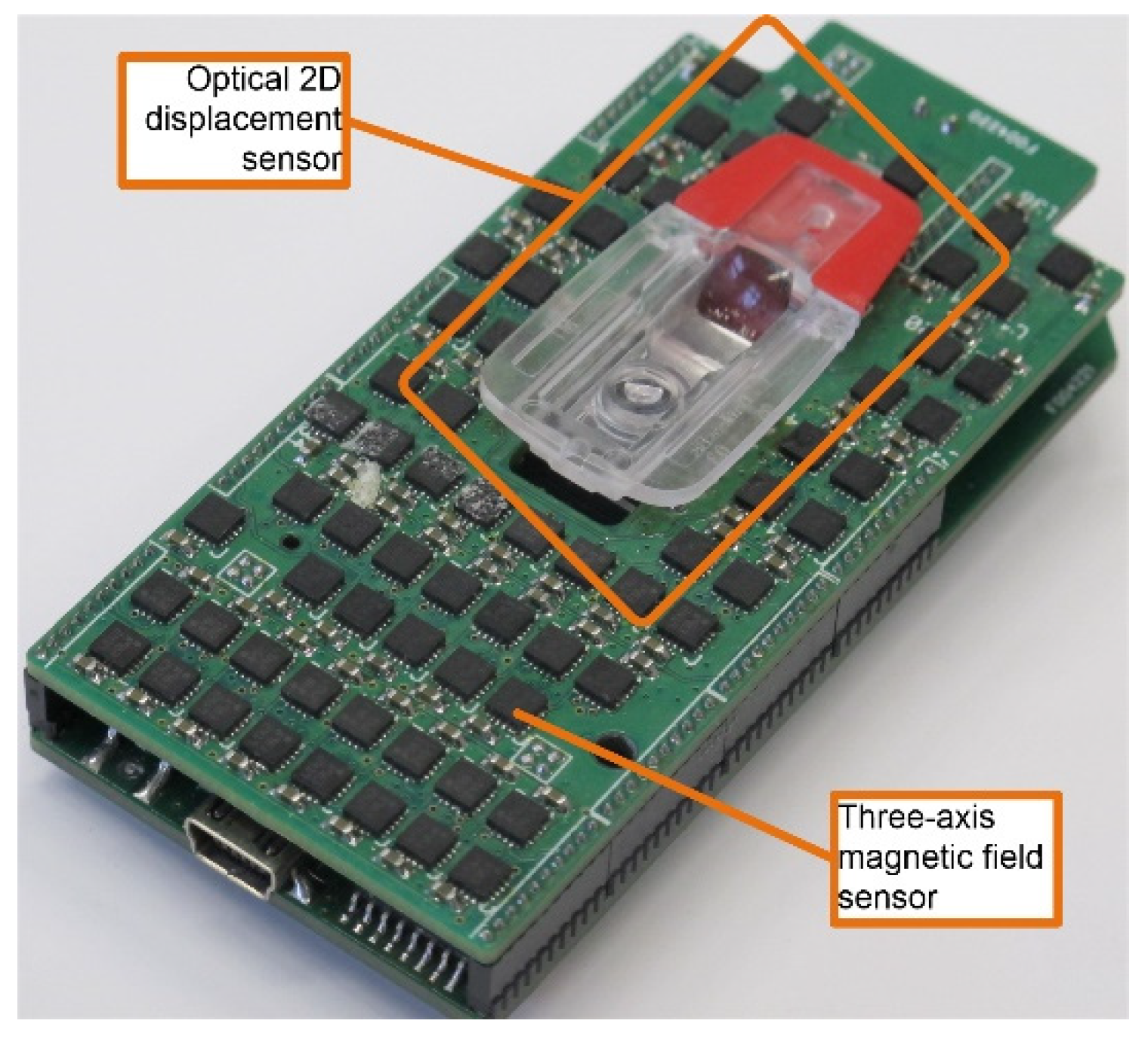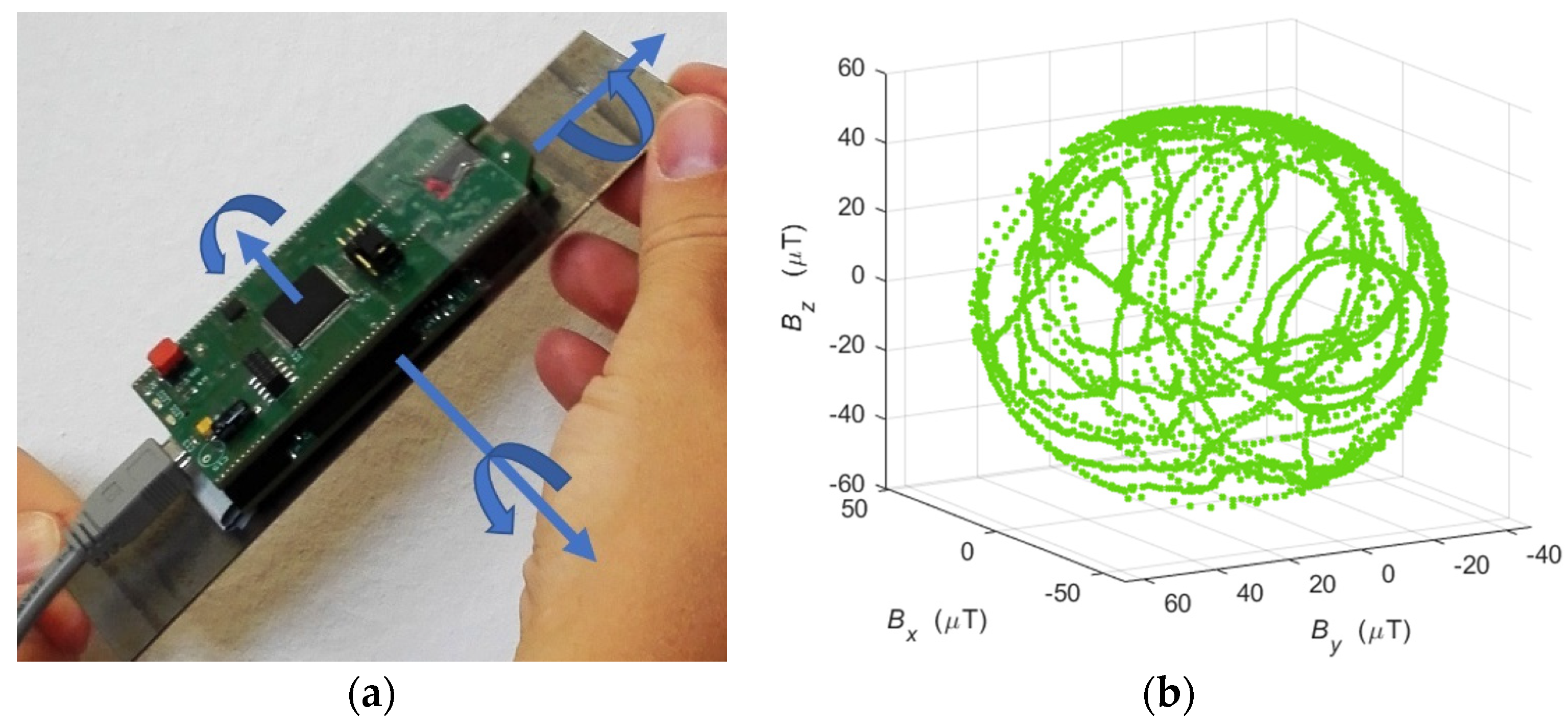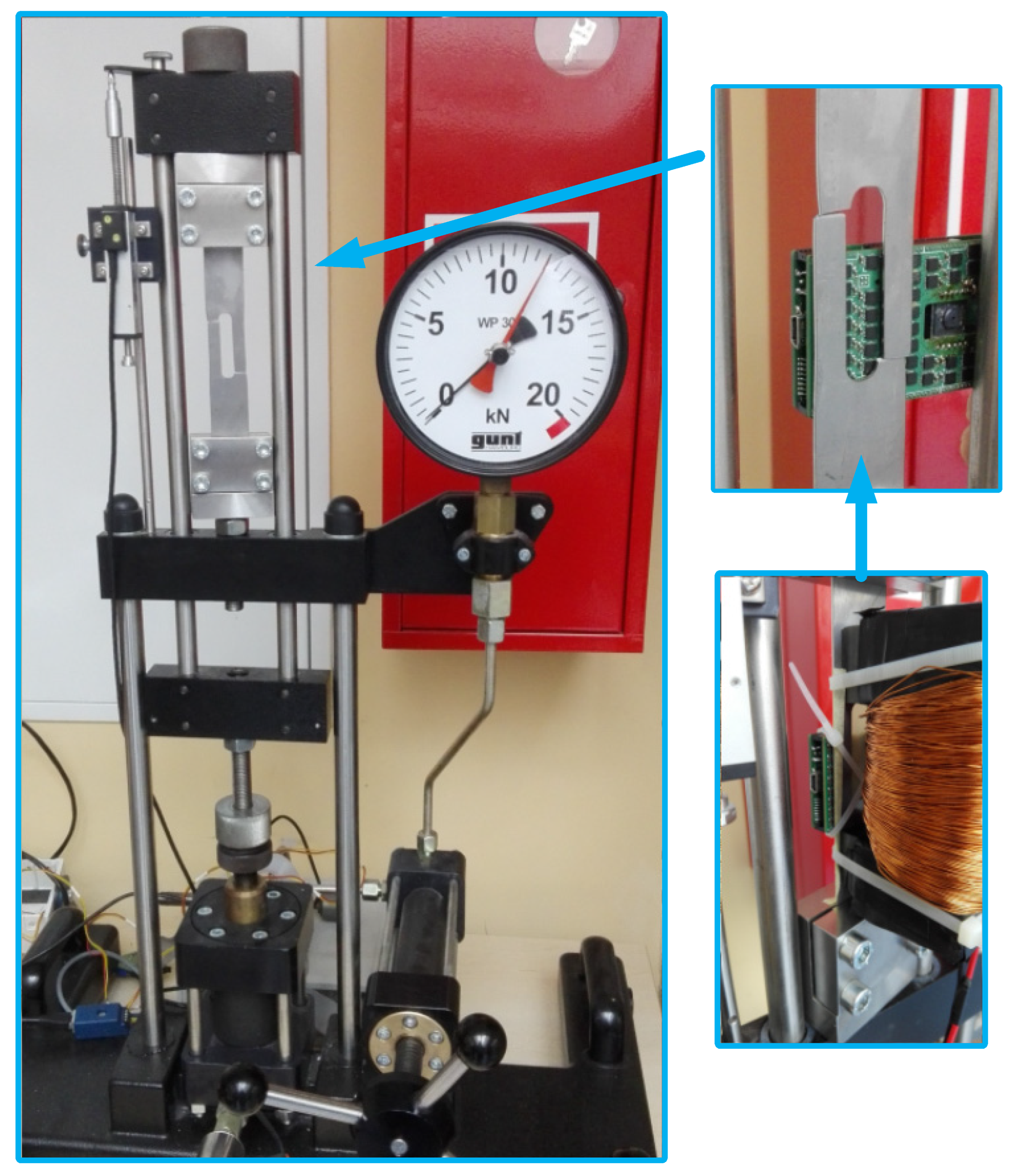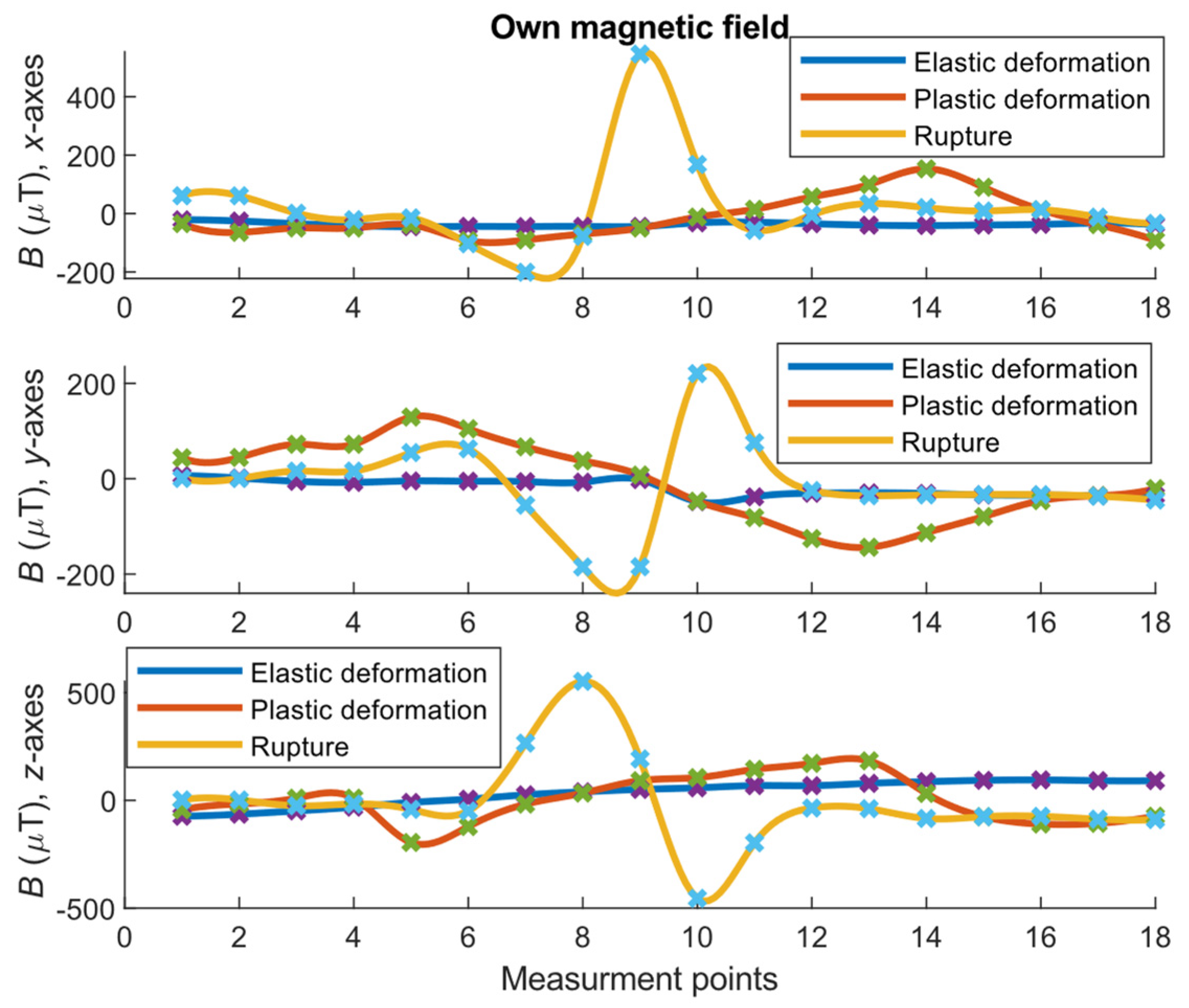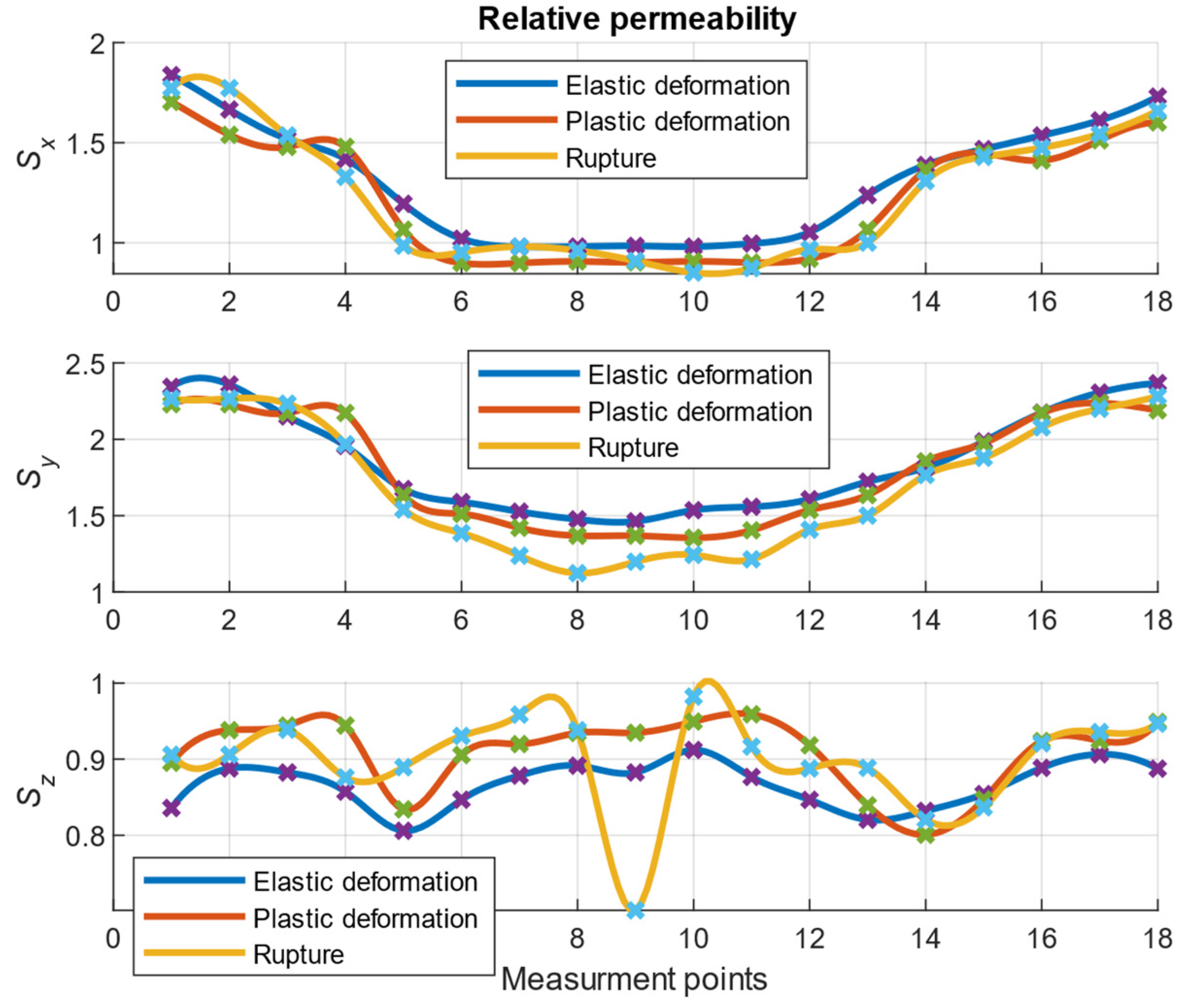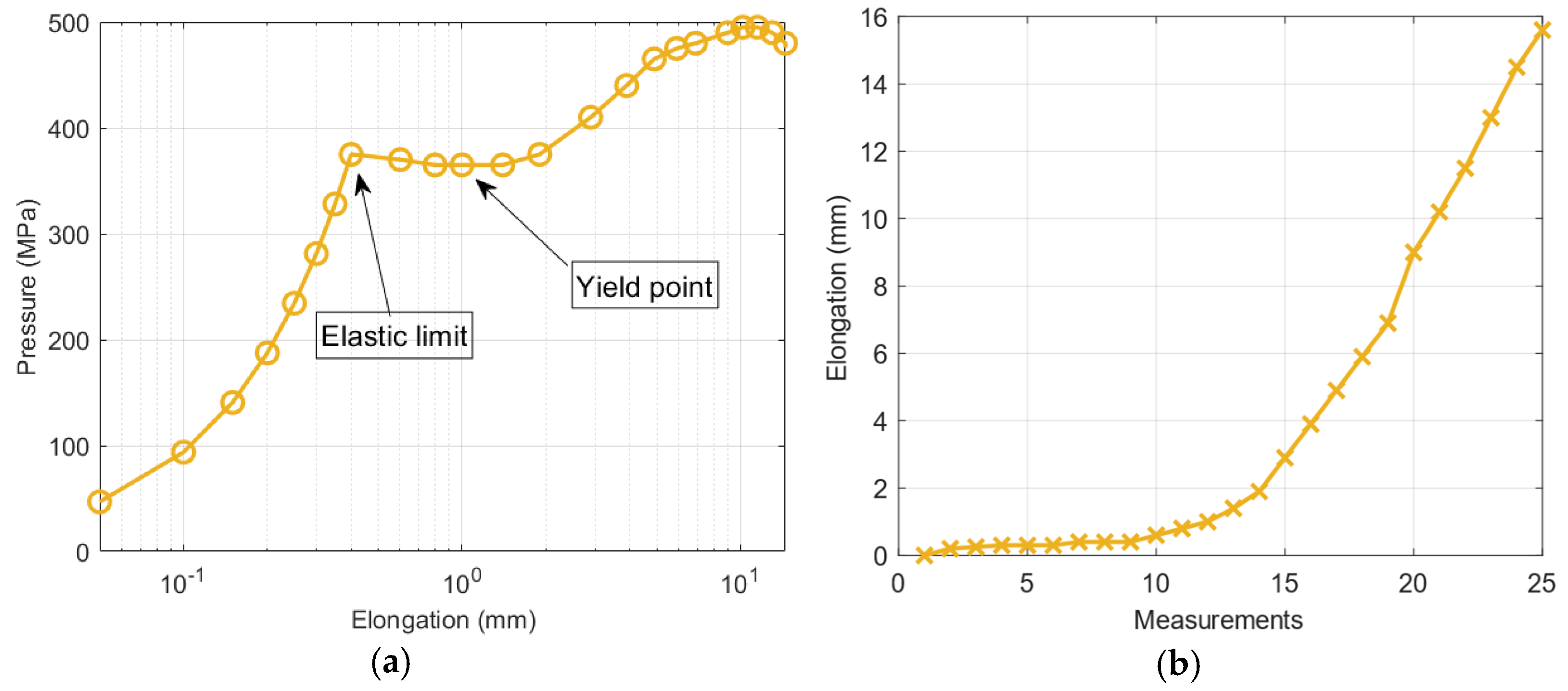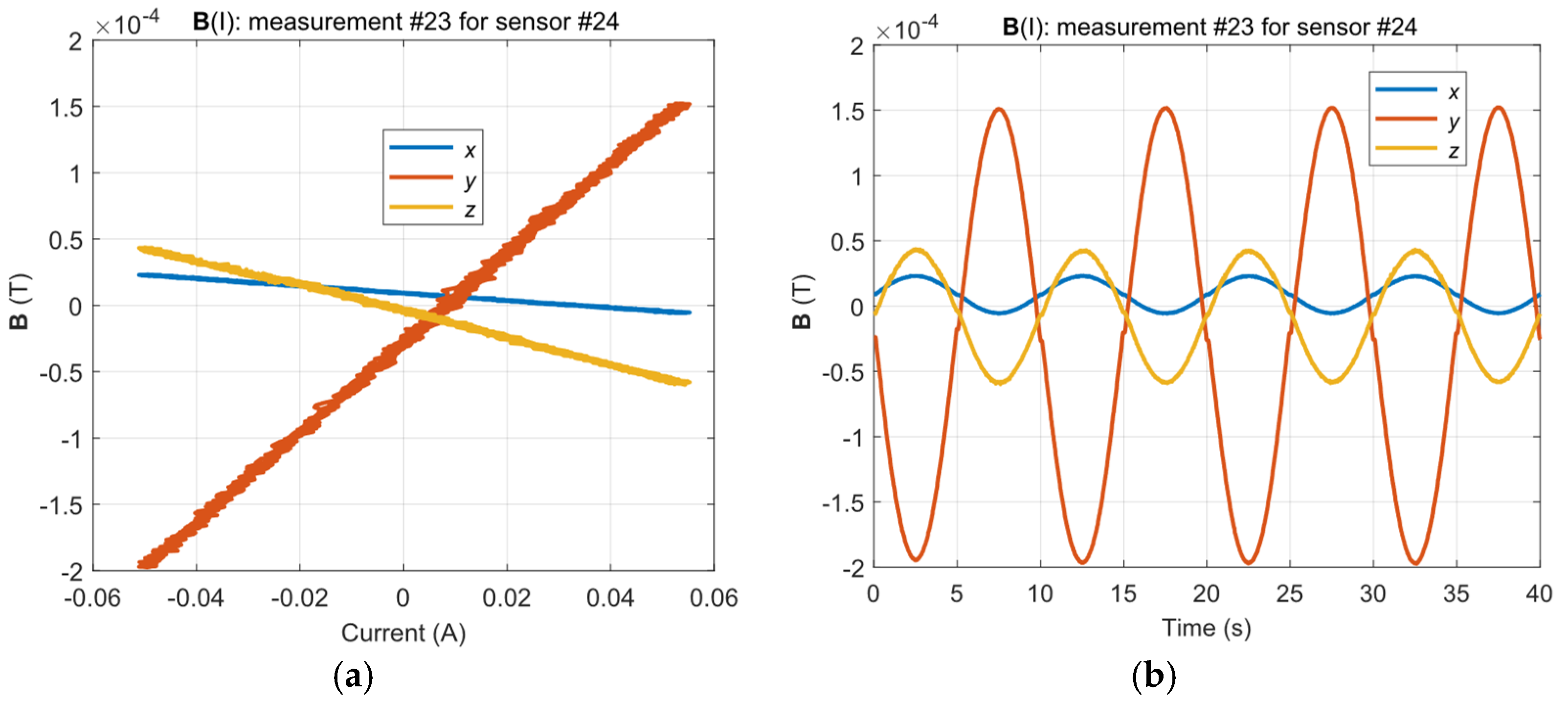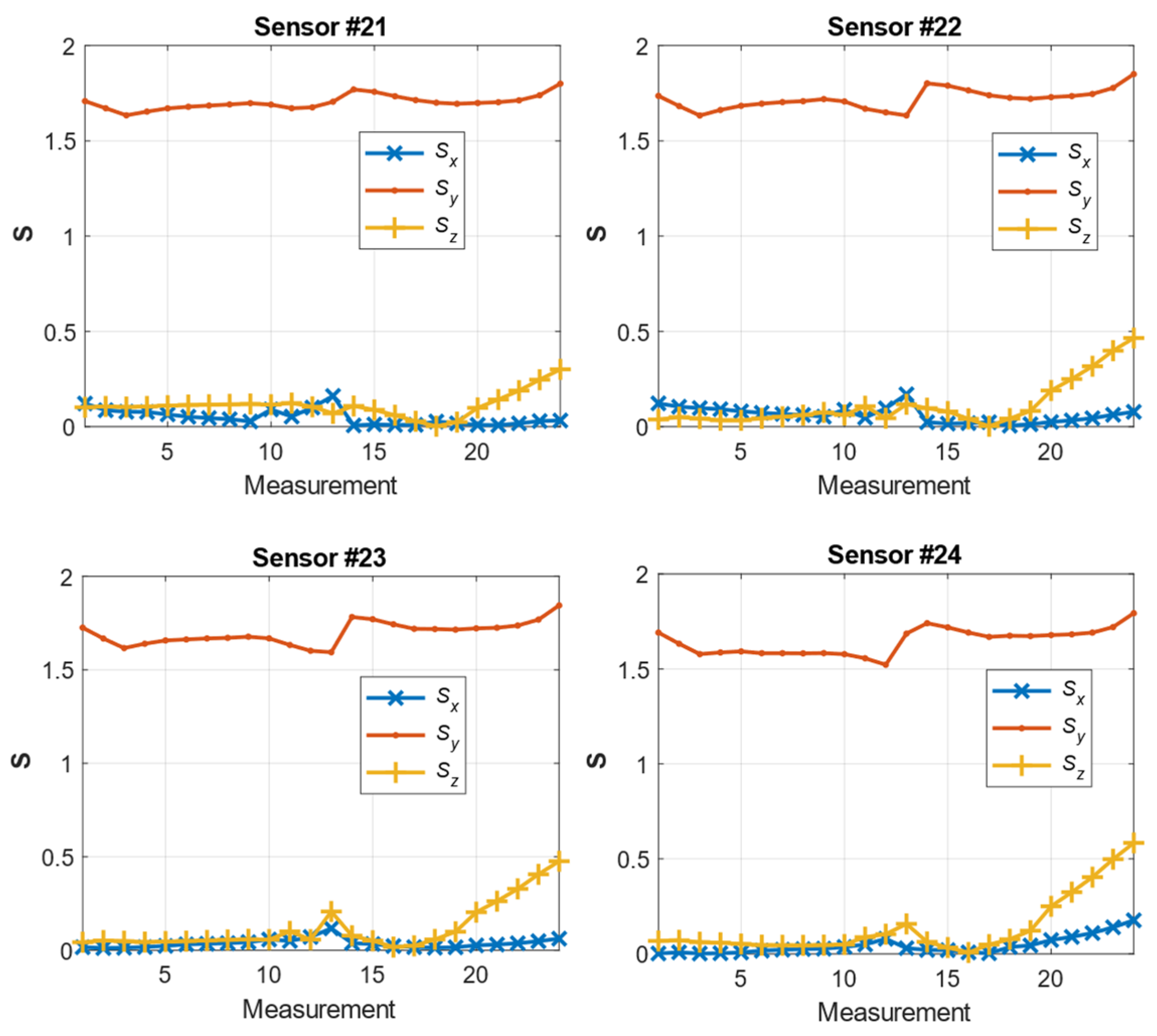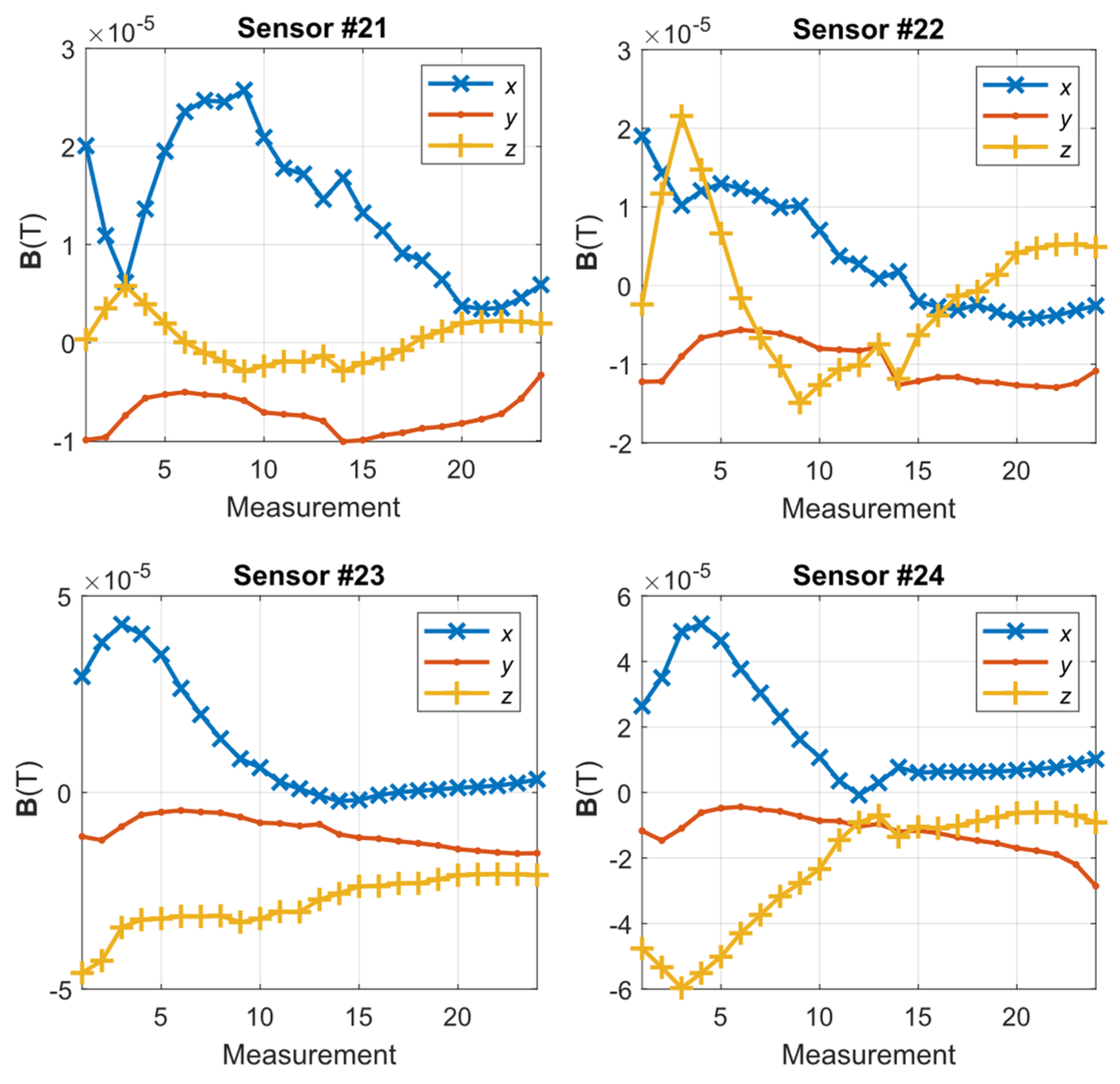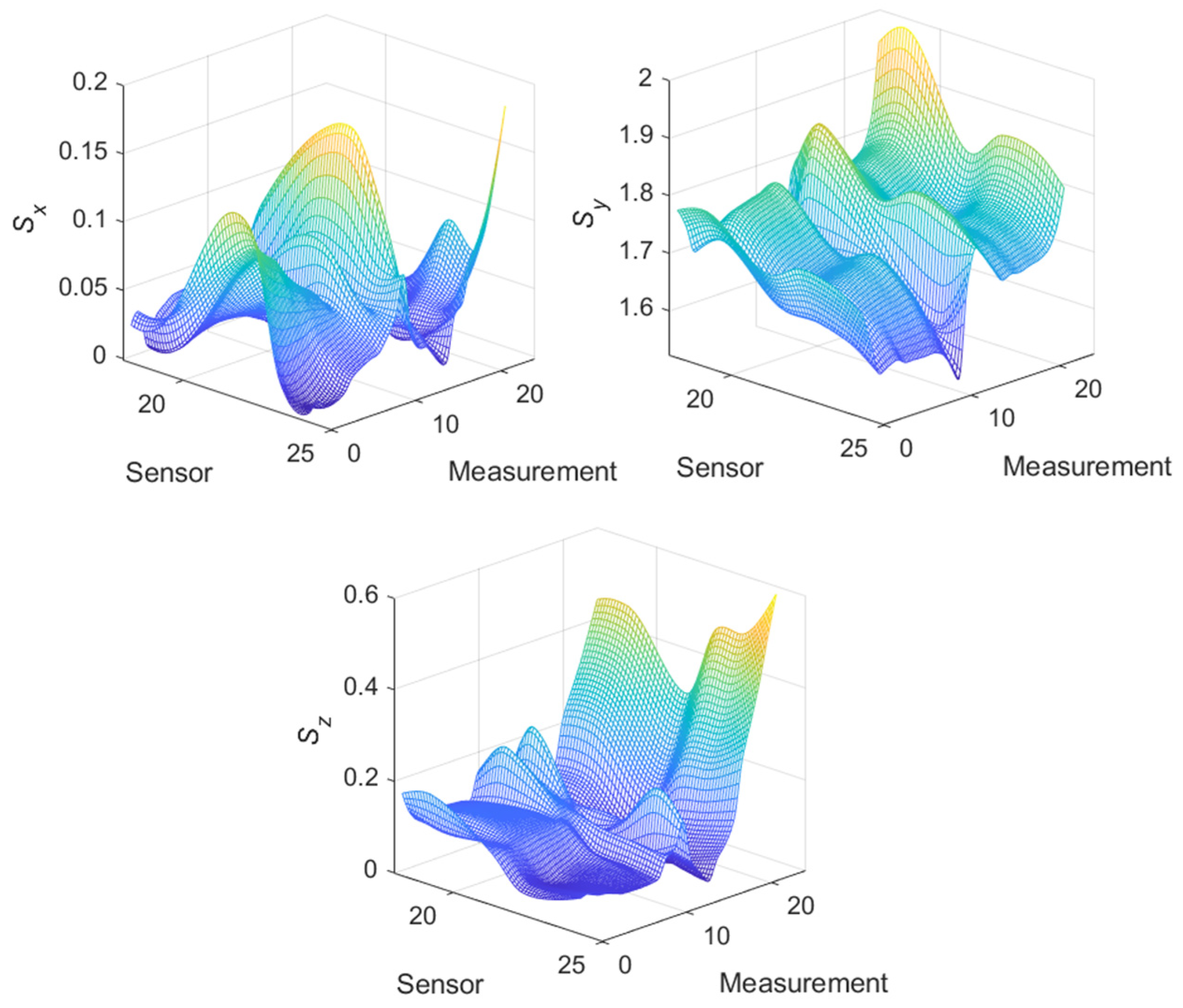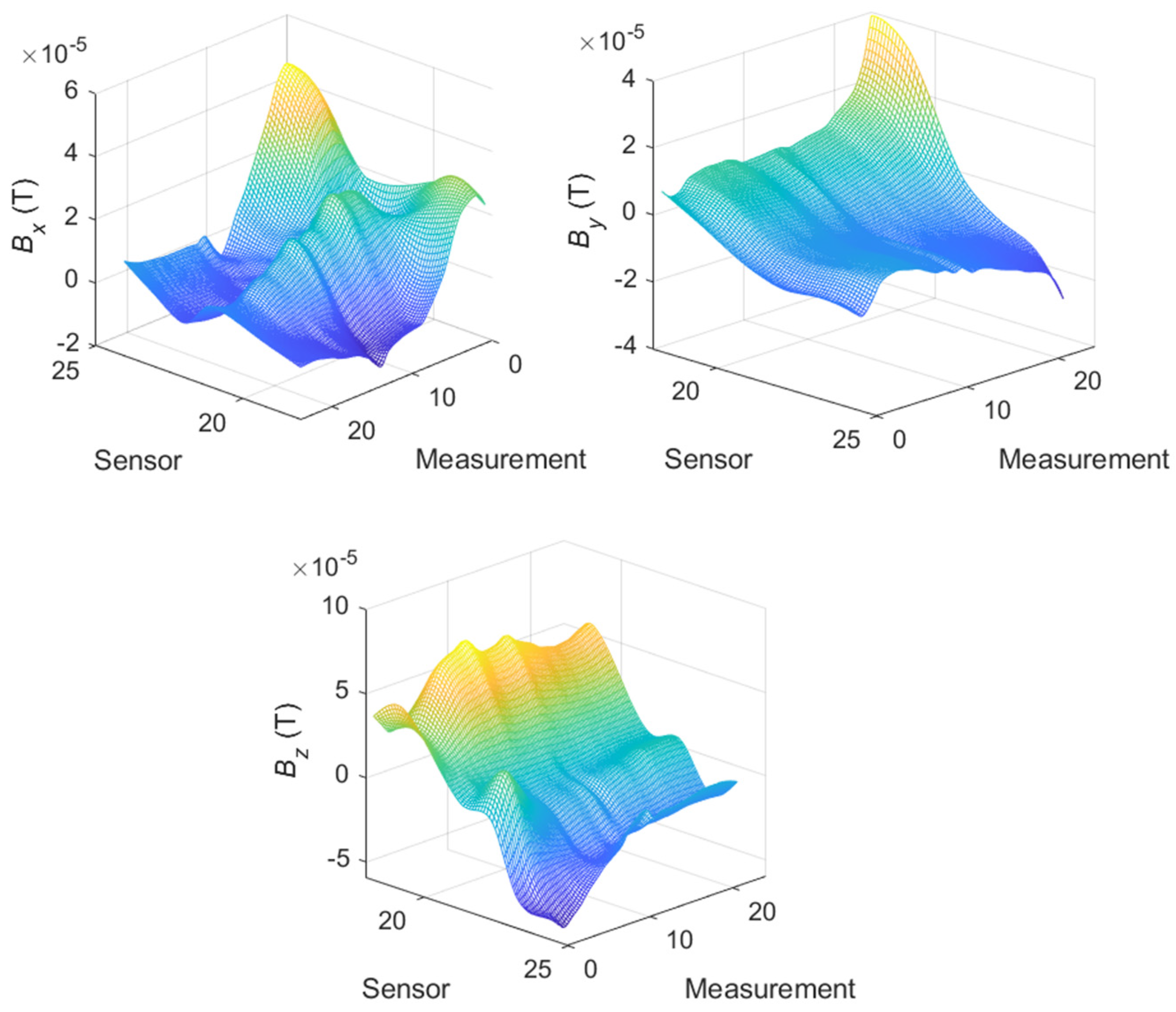1. Introduction
Many materials and machines that can present a real risk of a catastrophe due to fatigue wear, exceeding stress limits, or the appearance of plastic deformation have magnetic properties that can affect the local magnetic field, making it possible to increase the variety of nondestructive techniques, which are necessary for the modern management of technical facility operations [
1,
2,
3]. For this reason, along with the technological development of magnetic sensors and measuring instruments, magnetic methods have recently become very attractive. Additionally, bearing in mind the consequences of unforeseen architectural failures and failures of technical facilities, it is necessary to advance science toward the technology of detecting early stages of damage, which is possible thanks to the use of magnetic methods [
4,
5,
6].
In general, magnetic techniques are divided into active and passive techniques. Currently, the group of active magnetic methods is quite large and widely used. The main methods representing this family include the magnetic noise method (Barkhausen method), eddy current method, powder technique, and a method based on magnetic flux leakage. These types of tests require specialized, usually complex, measuring equipment, and the obtained results are sometimes ambiguous. However, these methods enable the detection of the most dangerous defects: flat surface defects and narrow gap defects. Although they play a very important role in technical diagnostics, the methods are adapted to detect existing defects. In parallel with the development of active diagnostic methods, the development of a group of passive diagnostic methods can be observed, which have all the advantages of active methods but, at the same time, do not require the use of artificial sources of magnetic fields, which is associated with the use of complex and expensive devices. The methods that can detect damage in the nucleation phase are the following methods: magnetoacoustic emission (EMA), metal magnetic memory (MMM) method, and other passive techniques [
7,
8,
9,
10,
11,
12,
13], which only use the existence of the natural magnetic field of the Earth. These methods are becoming increasingly popular and are the subject of intensive research.
However, due to the variety and complexity of magnetomechanical effects, it is difficult to identify the quantitative measures that allow us to precisely define the diagnostic thresholds for specific magnetic signals. Recently, the most widely used approach is to acquire the magnetic signal by scanning the spatial distribution of the magnetic field of the sample [
14] (e.g., MPM). This method uses the phenomenon of memorizing the effects of cyclical and boundary loads on the structure of the material and analyzes the residual magnetic field [
15]. Such an assumed phenomena model of an object is very simplified because it does not even take into account changes in magnetic properties, e.g., permeability of the material, with a change in the stress state of the material [
16]. Moreover, the current state of the art shows that new models are needed to match the magnetomechanical phenomena [
17]. The relationships existing in the field of plastic deformation seem to be particularly problematic because traditional magnetic–stress coupling models are based on the magnetoelastic theory, which cannot explain magnetic phenomena in the plastic deformation range [
18]. The results obtained by scientists indicate new possibilities of describing and modeling phenomena, which better describe the observed reality. Along with the new description of physical interactions, new measurement and analysis methods are necessary that will use the emerging possibilities of obtaining information regarding the magnetic signal [
19], both in terms of the elastic and plastic deformations. In both these cases, changes in the mechanical properties of the construction material entail changes in the magnetic properties, mainly the magnetization and permeability of the material [
20]. The influence of both parameters is observed by the measuring equipment in the magnetic field around the structure but without the possibility of separating them. The possibility of a separate analysis of both factors could significantly contribute to improving the quality of the estimation of the technical condition of the structure.
Regarding this issue, the next chapter indicates potential physical phenomena that are related to the magnetic signal, which may contain useful diagnostic information for the objects under consideration. Next, the article discusses the issue of selecting a sensor with the appropriate sensitivity and the problem of how to observe the magnetic signal, i.e., whether it is to be a measurement at a point, on a certain observation plane, or whether a spatial measurement is needed. These considerations lead to the idea of fusing information from multiple additional sensors, which may prove pivotal in the proposed approach. The next part of the article describes the key stage from the point of view of diagnostics, i.e., finding a magnetic diagnostic parameter that will be sensitive to degradation changes taking place in a technical facility [
21,
22]. Chapter 3 presents the mathematical basis of the method of information separation from the magnetic field to extract the information that is most closely related to the technical condition of the material. The following chapters describe two experiments and an exemplary interpretation of the results. The first experiment involved flat samples made of 3H13 stainless steel in various stress states. The second involved an analysis of changes in the distribution of the magnetic field on a sample that was carried through successive states of stress until breaking. The proposed methodology, including the process from planning the experiment and selecting the measurement path, through the measurement, to the extraction of diagnostic information, cannot be clearly assigned to either the passive or active magnetic technique. However, it has been shown that the optimal performance of the entire proposed process may lead to the acquisition of qualitatively and quantitatively appropriate magnetic information. By appropriately transforming this information, it was possible to identify specific magnetic, electromagnetic, or magnetomechanical phenomena. The analysis of these phenomena related to the working conditions and the condition of the technical object led to finding an appropriate diagnostic measure that, in accordance with the nature of magnetic methods, described the early stages of the occurring damage.
2. Theoretical Background
To utilize the new diagnostics information pertaining to the functional properties of technical objects, we recommend the analytical estimation of the cross-effects, especially those pertaining to the mechanics and magnetics [
21,
23,
24,
25,
26,
27]. Certain researchers indicated that as the stress condition changes in a material with magnetic properties, the material exhibits a magnetic state, which can be shown by the change in the material magnetization intensity. The magnetization intensity can be attributed to the magnetomechanical phenomena, which might be affected by the static or dynamic loads applied to the material specimen and can be appropriately recorded and analyzed if required.
Furthermore, this impact varies depending on the “quantity and quality” of the material that the specific object is made from. Certain bodies can generate a magnetic field around them. Other objects, when placed in an external magnetic field, lead to a distinct change in this field. To model this aspect, the magnetic properties of a ferromagnetic object can be described as a set of magnetic dipoles (
mi) that are bound together with microcurrents. According to this concept, the magnetic features of a body of a set of dipoles can be characterized by the magnetization vector
M, which can be defined as a resultant magnetic moment per unit of volume:
To render the equation transparent and more usable from the diagnostics viewpoint, the following expression can be formulated on the macroscopic scale:
λ and ω are the components of magnetostriction (λ = Δl/l and ω = ΔV/V for linear and volumetric measures, respectively), and E and υ denote Young’s modulus and Poisson’s ratio, respectively.
When a permanent layout of the magnetic moments occurs, the specimen exhibits external magnetic features (poles). This behavior is typical for permanent magnetic materials, including ferromagnets. In general, ferromagnetic materials include iron, cobalt, nickel, and certain transitional metals pertaining to iron and rare earth elements. When performing diagnostics on engineering structures that are built mainly from steel or cast steel, it is preferable to operate with ferromagnetic soft materials, which usually lose nearly all their magnetization once the magnetizing field is removed and exhibit only residual magnetism, which is considerably smaller than the maximum magnetism. For such materials, the resulting value
M changes substantially due to an external magnetic field or other physical influences on the object in the presence of such an external field [
16].
The ferromagnetic behavior can be explained with reference to Weiss’ theory of domains, which indicates that each ferromagnetic material consists of magnetic domains wherein the atoms are arranged in 3D crystal lattices and demonstrate magnetic moments (nonvanishing magnetization vectors). In practical magnetization, the phenomena related to changes in the magnetization state
M, are highly complex; however, these phenomena can be approximated through a first magnetization curve, as shown in
Figure 1.
First, the evolution of the domain structure is reorganized by domain wall displacement. Next, the moment rotation attempts to align the moments of individual areas of spontaneous magnetization parallel to the external field. Finally, the paraprocess occurs, in which after the technical saturation point, as many domains as possible follow the direction of the outer field. A further increase in the magnetic induction occurs with an increase in the H field intensity.
The described process refers to an idealized case and is a classic description that is appropriate for the response of a material to the excitation in the form of a change in the magnetic field intensity. However, the actual process is highly complicated because the movements of the walls and rotary movements may overlap, and the nature of the movements is strongly dependent on the structural features of the ferromagnetic material. In this scenario, the specific border points of the domain changes may be ambiguous. In addition, in the presence of other physical influences (see Equation (2)) on the object placed within even a weak magnetic field, the magnetization involving the rotary movement of the domains cannot be excluded, as indicated by the irreversible and nonlinear effects [
16].
The described phenomena and behavior of the magnetic material are analogous in the case of magnetization involving magnetomechanical effects, as the mechanical interactions may modify the primary magnetization curve.
According to Equation (2), which presents the magnetization model, and the results of the experiments, a change in the material structure (degradation), stress distribution, material temperature, or magnetic field intensity can influence the magnetization intensity distribution layout
M(
x,
y,
z) and magnetization intensity distribution of the magnetic induction
B(
x,
y,
z) in the vicinity of the object being tested. Therefore, the reading of the magnetometer should be understood as an association between the magnetization
M, the intensity of the external magnetic field
H, and the magnetic induction
B, as expressed in the constitutive law equation:
where
μ is relative permeability and
μ0 is permeability of free space. The relationship between the magnetization
M, the intensity of the external magnetic field
H, and the magnetic induction is a scientifically proven theorem to support nondestructive magnetic testing and monitoring of the structures using active and passive methods.
In general, one can identify three methods of interaction that produce magnetization changes that occur in accordance with the previously described domain processes:
Stress-affected change via deflection (deflection change in the elastic strain or plastic strain range);
Change caused by thermal effects (heating the material to a temperature in excess of the Curie point);
Electromagnetic change (by the action of an external magnetic field).
Electromagnetic magnetization is specific to active methods, while temperature-affected magnetization corresponds to temperatures close to the Curie point. In contrast, in the case of passive methods, the key issue pertains to the stress-affected magnetization.
The stress-affected magnetization procedure in a weak magnetic field (at the level of the natural magnetic field on the Earth’s surface) is essentially different from the technical magnetization procedure conducted under a strong (>>50 A/m) permanent or variable magnetic field, as is currently implemented in non-destructive testing (NDT) inspections. The comprehension of only these variances could provide adequate bases to realize quantitative and qualitative interpretation of the measurement results and enable the fully controlled employment of the observer of the state to diagnose technical objects. In this regard, it is desirable to simplify the numerical model of stress magnetization in a weak magnetic field, which is highly complex compared to that of technical magnetization. The associated division is based on the need to separate both the reversible effects (the Villari effect and its derivatives) and irreversible effects (Δ
E effect, energy dissipation via Barkhausen noise, change in the magnetization observed after unloading the material, austenite–martensite phase transformation), as indicated in Equations (4)–(6). This division is consistent with the experimentally confirmed mechanism of reversible moving domains and the corresponding irreversible rotation. This division can be expressed in the analytical form as follows:
where
is stress,
is temperature,
is Rayileigh coefficient,
is magnetostriction and
is magnetic susceptibility. The adopted division highlights a certain analogy. The influence of stresses on the magnetic induction produced by an object in a constant external magnetic field can be equated with the change in the magnetostriction under the influence of an external magnetic field at a constant level of stress. However, for the area in which the magnetoplastic phenomenon occurs, the magnetization increases in proportion to the number of cycles of mechanical excitation. With regard to the proposed model, it is advisable to introduce the notion of the “eigenmagnetic field” [
16] as a global signal of the magnetic field recorded by the magnetometer. The “eigenmagnetic field” describes the behavior of a magnetoelastically activated material in a weak magnetic field surrounding the material. The concept is broader than that of the diffuse magnetic field because it considers the complex reversible and irreversible effects. This concept allows for the description of a greater number of physical phenomena that more accurately define the state of stress and strain of the material. This description is valuable; however, to obtain this detailed information, the observation method must be extended to include all components of the magnetic field (in the case of self-magnetic flux leakage (SMFL), two components are sufficient) and use appropriate techniques that enable the separation of the effects of interest. The starting point for this concept may be a model description of the reversible/irreversible phenomena, which can be expressed as
where the magnetic induction
BP measured in the vicinity of the sample is described. The measurement value includes the component of the terrestrial magnetic induction
BE, and component
BM can be attributed to the permanent magnetization of the sample. The diagonal matrix
S defines the effect of the closeness of the magnetic material with relative permeability
μr ≥ 1. Matrix
R represents the transformations of the local terrestrial field components that are bound in an inertial system to a local magnetic field when observed in a relative system coupled with the tested sample.
A significant limitation to the practical use of this type of model is the complexity of the material structure, access to a limited number of measurements, and the presence of external disturbances. In this regard, the proper recording of the magnetic signals, processing, analysis, and interpretation can enable the enhancement of the capabilities of magnetic diagnostic methods. Consequently, methods that can more accurately estimate the degree of material strain or material degradation are being developed by extracting the information that is not normally available in the measurements. The two proposed methods are discussed in the next section.
6. Summary
The tests conducted on steel samples showed that an area of stress concentration caused local magnetization of the material, in accordance with the theoretical assumptions. This phenomenon can be used to identify the stress state of a material in the elastic region. However, in the plastic state, the spatial fluctuations of the field were considerably smaller and exhibited different characteristics. These results could be obtained using the proprietary model approach and the conduction of an experiment appropriate for this model. However, the proposed technique involved certain practical limitations due to the required movement of the examined object in relation to the external magnetic field. Therefore, a second experiment was performed, in which stimulation through a modeled external weak magnetic field was incorporated while the sample remained in place. The results for the simplified experiment indicated that this scenario did not disrupt the effects observed in the first experiment. However, in the field of plastic deformation, changes in the field dispersion parameter occurred, which were considerably smaller in the elastic region. Using the proposed method of information extraction, two pieces of information from the eigenmagnetic field signal of an object could be isolated, which reflected the different effects occurring in different states of the material strain. The information obtained from the magnetic field without separation corresponded to a considerably challenging interpretation of the obtained image of the magnetic field distribution. Both effects related to the sample’s inherent magnetization and change in the magnetic permeability affected the resultant distribution of the magnetic field (eigenmagnetic field), and consequently, the measurement of the recorded magnetic field. The boundary of the passage through the two characteristic areas of material strain was very difficult to detect. In addition, the analysis of the individual components of the magnetic field in the described tests enabled the realization of a more accurate inference regarding the direction of stress (the preferred direction of magnetization). Both types of estimated parameters, specifically, the sample’s inherent magnetic field and changes in the permeability, indicated a strong correlation between the directions of the recorded field and force. Therefore, the extension of the experiment from the variant with stationary sample II while controlling the spinning of the forcing field in three planes facilitated the understanding of the relationships between the estimated parameters and state of stress in the sample material.
This presented research did not include cyclic loading of the material. Although such an experiment would be interesting, it is possible to conclude that our magnetic parameters will still be usable and show characteristic behaviors. According to Figures 6 and 7 in [
16], in the elastic strain area, some irreversible effects could appear. The proposed diagnostic magnetic parameters should agree with this effect in a quantitative manner that is proportional to the share of reversible and irreversible effects. In the same situation, one can predict the plastic range [
30], where the quantitative changes will only influence the proposed parameters in the range of values considered in the present paper. On the other hand, the benefit of extracting magnetic field features should be emphasized in the availability of diagnostic information in the face of low-energy changes or disturbances. Nevertheless, it would be worth doing special research on this topic. Finally, we concluded that the observation of both parameters can be realized to enable a more reliable assessment of the stress state of the material. During the analyses, a characteristic jump of the
S parameter was observed at Yield point (
Figure 10a) of the material strength curve, which was related to the change in the permeability of the sample. This behavior is interesting and the resulting phenomena will be examined in future work.
